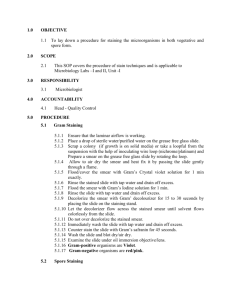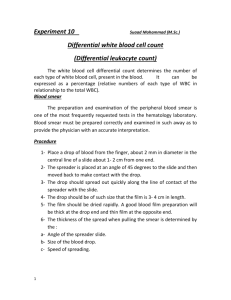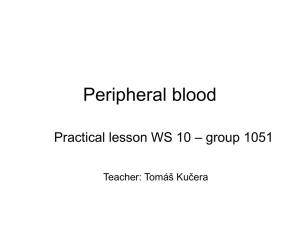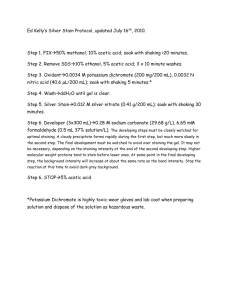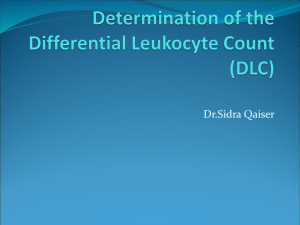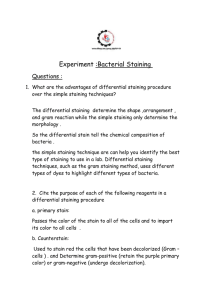Chapter - 4 : Microscopic Examination
advertisement
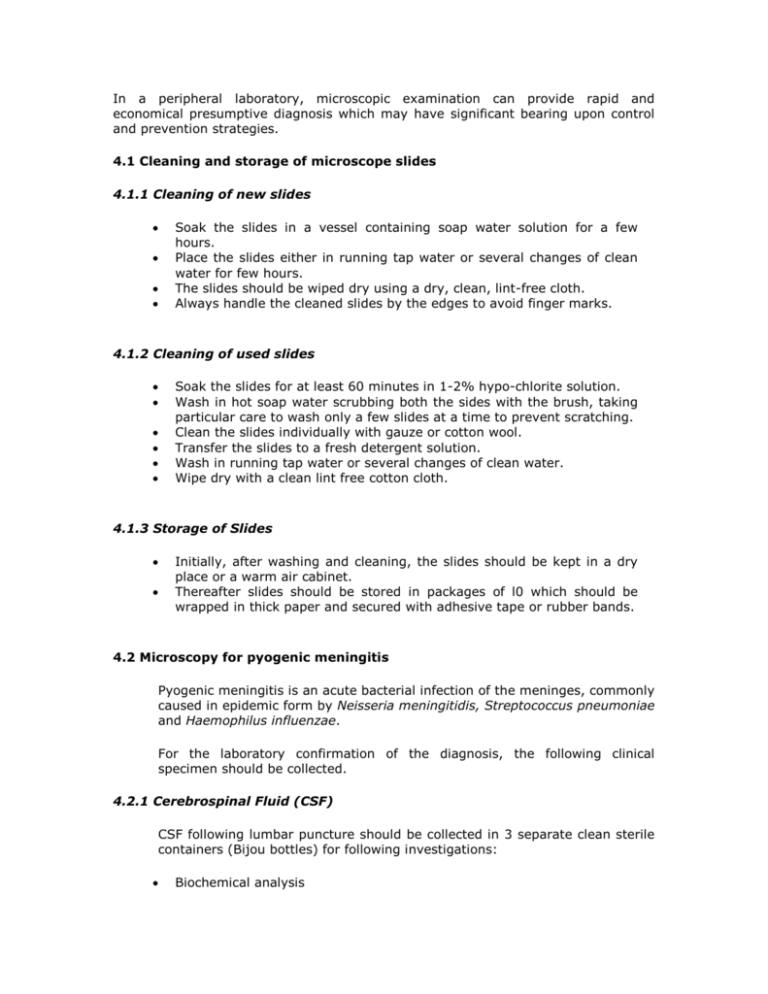
In a peripheral laboratory, microscopic examination can provide rapid and economical presumptive diagnosis which may have significant bearing upon control and prevention strategies. 4.1 Cleaning and storage of microscope slides 4.1.1 Cleaning of new slides Soak the slides in a vessel containing soap water solution for a few hours. Place the slides either in running tap water or several changes of clean water for few hours. The slides should be wiped dry using a dry, clean, lint-free cloth. Always handle the cleaned slides by the edges to avoid finger marks. 4.1.2 Cleaning of used slides Soak the slides for at least 60 minutes in 1-2% hypo-chlorite solution. Wash in hot soap water scrubbing both the sides with the brush, taking particular care to wash only a few slides at a time to prevent scratching. Clean the slides individually with gauze or cotton wool. Transfer the slides to a fresh detergent solution. Wash in running tap water or several changes of clean water. Wipe dry with a clean lint free cotton cloth. 4.1.3 Storage of Slides Initially, after washing and cleaning, the slides should be kept in a dry place or a warm air cabinet. Thereafter slides should be stored in packages of l0 which should be wrapped in thick paper and secured with adhesive tape or rubber bands. 4.2 Microscopy for pyogenic meningitis Pyogenic meningitis is an acute bacterial infection of the meninges, commonly caused in epidemic form by Neisseria meningitidis, Streptococcus pneumoniae and Haemophilus influenzae. For the laboratory confirmation of the diagnosis, the following clinical specimen should be collected. 4.2.1 Cerebrospinal Fluid (CSF) CSF following lumbar puncture should be collected in 3 separate clean sterile containers (Bijou bottles) for following investigations: Biochemical analysis Cytological examination Microbiological tests General guidelines for collecting CSF CSF should be collected before the start of chemotherapy. Never refrigerate or expose it to sunlight, and transport immediately to the laboratory. In case of delay in transportation, keep CSF at 37oC. Other clinical samples which can be collected are blood and petechial fluids. 4.2.2 Examination of CSF Macroscopic: Look for the presence of turbidity, blood or coagulum. Cytology Cytologic examination to be done only when there is no coagulum in the CSF. Material Required: chamber, The cell count should be done by the usual procedure of WBC count using a Neubauer's chamber and count the number of leukocytes per cmm of fluid. The normal CSF should be absolutely clear, free of any coagulum and should not contain more than 0-8 lymphocytic cells/cmm. In pyogenic meningitis, appearance of CSF is turbid and contains more than 8-10 leukocytes/cmm, the cells being predominantly polymorphs in nature. Microbiological examination: Microscopy Microscopic examination is required to directly visualise the causative organism in the CSF. Requirements Clean slides Coverslips Table top centrifuge Centrifuge tubes Pasteur pipettes Clean glass vials Reagents of Gram's staining. Rubber teats Discarding jar Neubauer counting chamber WBC pipette. o o o o o o o o o o o Procedure: Transfer about 1-2 ml of CSF in a sterile centrifuge tube. Centrifuge at 3000 rpm for 5 minutes. Keep the supernatant fluid for Latex Agglutination test. From the deposit, make smears on 3 clean glass slides and air o o o o dry. o o o o o o In case of a clotted CSF, transfer 3 small pieces of clot on three different glass slides. Tease the clots using needles or wooden sticks or the edge of the slide and after spreading make the smears. Air dry. In case of scanty CSF, several drops of CSF should be placed at one particular spot on the slide, each being allowed to dry before the next is added. Air dry and heat fix the smear. Stain the smears by Gram's staining method as given subsequently. Examine under oil immersion lens. Observations o o Presence of Gram negative bean shaped diplococci, both intracellular and extracellular suggests the presence of Neisseria meningitidis (Meningococcus). Other organisms which can be seen are Streptococcus pneumoniae (Pneumococcus), which appear as gram-positive diplococci, Haemophilus influenzae which appear as gram negative thin filaments rods. 4.3 Diagnosis of pulmonary tuberculosis by sputum examination: Tuberculosis is a disease of great public health importance caused by Mycobacterium tuberculosis and some other species of Mycobacteria. The diagnosis of pulmonary tuberculosis can be established by demonstrating the bacillus in the sputum of the patient by microscopy. 4.3.1 Sputum collection Collect the sample preferably early in the morning. For optimum results, 3 consecutive days samples should be tested. In case sputum is scanty, a 24 hour collection may be examined. A nebulized and heated hypertonic saline may be used to induce sputum production in patients unable to bring out the sputum. Sputum should be collected in a sterile wide mouthed container with a tight lid. The sample should be delivered to the laboratory with minimum delay. Specimen that cannot be delivered or processed immediately should be refrigerated at 4-8oC for a maximum of 3-4 days. Materials required for sputum microscopy: Properly collected sputum specimen Wooden sticks Clean glass slides Spirit lamp/Bunsen burner Petri dish Inoculation hood Face masks Reagents for Zeihl-Neelsen staining Glass rods, plastic clay. Procedure: Preparation of the smear In an inoculation hood or in an isolated room, wearing a face mask, transfer a portion of the sputum to a petri dish. Using a wooden stick, tease out a small portion of caseous, purulent or bloody material and transfer it to a clean slide. Using the same wooden stick or an inoculating wire loop, spread this material uniformly over a large area, covering at least two thirds of the slide. Air dry the slides and flame them immediately and stain according to the Ziehl-Neelsen staining method as given below: 4.3.2 Ziehl Neelsen Staining (Acid fast staining) Requirements Carbol fuchsin solution 20% sulfuric Acid 95% alcohol Loeffler's methylene blue Distilled water Staining Procedure: Put the heat fixed smears onto a platform made using two parallel glass rods over a wash basin. Cover the slide with carbol fuchsin and heat the slide from below until steam rises. Do not boil the stain. Allow the stain to act for 5-8 minutes with intermittent heating, putting fresh carbol fuchsin on the slide from time to time. Care should be taken not to allow the stain to dry on the slide. Wash the slide preferably using distilled water. (Do not use tap water). Cover the slide with 20% sulfuric acid. Wash the slide with water after one minute. Pour more acid and continue decolorisation till smear is just faint pink. Wash the slide again with water. Cover the slide with 95% Alcohol for 2 minutes. Wash with water. Counterstain with Loeffler's methylene blue for 30 seconds. Wash the smear with tap water, air dry and examine under oil immersion. Observations: Mycobacteria appear as bright pink, slender, slightly curved rods, whereas the background tissue, cells and other organisms are stained blue. Note : Staining jars should never be used as with a positive stained slide, the bacilli may get detached from the slide and float about in staining fluid later on sticking to the negative slides and may give false positive results. After examining a positive slide, take care to wipe the lens with a clean tissue paper before examining the next slide. Do not record the smear to be negative unless at least 300 microscopic fields have been thoroughly examined under oil immersion objective. Never re-use a positive slide 4.4 Diagnosis of plague Plague is an ancient scourge of mankind. It is a bacterial disease caused by Yersinia pestis. It is enzootic in rodents. In man, plague occurs mainly in three forms, bubonic, pneumonic and septicaemic. The presumptive diagnosis of Plague can be established by microscopic examination. Sample collection: Bubo aspirate: Should be collected in bubonic plague. Under all safety precautions collect bubo aspirate by puncturing the bubo with a sterile hypodermic syringe and withdraw the exudate. Sterilize the puncture site with tincture iodine. l0 ml or 20 ml syringe, armed with l8/l9 guage needle and a few ml of sterile saline drawn into the syringe, should be used for aspiration of bubo aspirate. Bubo is then punctured and suction applied. If aspiration does not produce fluid, then saline is injected into the bubo and aspirated again. Transfer the exudate into a sterile container. Label the container. Transport to the laboratory at 2-8oC. 4.4.1 Sputum Collection in Pneumonic Plague: Collect the sputum sample in a sterile wide mouth screw capped container. Label the specimen Transport the specimen to laboratory at 2-8oC. In the Laboratory: Make three smears out of the same portion of exudate/sputum taking precautions not to form aerosols. Air dry the smear. Stain smears either by methylene blue/Gram staining/Wayson's stain. 4.4.2 Gram Stain This is a routine laboratory procedure used for examining specimens suspected to contain bacteriologic agents. Direct microscopic examination of specimens and cultures can provide a rapid presumptive diagnosis. Gram stain results, the shape of cell (cocci, bacilli), the type of cell arrangement (single, chained, clustered) visualized under light microscopy, can provide a quick assessment of what the etiologic agent may be. Principle The Gram stain forms the cornerstone of microscopic bacteriology. It was described by Hans Christian Gram over l00 years ago. Crystal violet (gentian violet) is the primary stain that will bind to the peptidoglycan present in the cell walls of some bacterial cells. Iodine is added as a mordant to fix the dye. If the cell wall does not contain peptidoglycan then crystal violet is easily washed off with acid or alcohol (decolorizer). A secondary dye, safranin (counterstain), is added after the decolorization step. If the primary dye did not bind, the cells will easily adsorb safranin. Thus gram-positive cells are purple, while gram-negative cells are pink/red. Requirements Crystal violet (0.5%) Gram's Iodine (1%) Acetone (100%) or Ethanol (95%) Safranine (0.5%) Procedure: Cover the slide with crystal violet solution and allow to act for about 30 seconds. Pour off stain and holding the slide at an angle downwards pour on the iodine solution so that it washes away the crystal violet; cover the slide with fresh iodine solution and allow to act for 1 minute. Wash off the iodine with ethanol and treat with fresh alcohol, tilt the slide from side to side until colour ceases to come out of the preparation. This is easily seen by holding the slide against a white background. Or Decolorize with 100% acetone. First, tip off the iodine and hold the slide at a steep slope. Then pour acetone over the slide from its upper end , so as to cover its whole surface. Decolorization is very rapid and is usually complete in 2-3 seconds. After this period of contact, wash thoroughly with water under a running tap. Apply the counterstain (0.5% safranine) for 30 seconds. Wash with water and blot dry When to use this procedure and what you expect to see: Y. pestis appear as fat, short, gram-negative coccobacilli about 1ì by 0.5ì. Gram stains are typically done on cultures/subcultures, bubo aspirates, spleen, liver and sputum smears. Critical value/Action to be taken: When gram stained material reveal small coccoid gram-negative bacilli, material should be further processed for culture isolation and identification. No notification is needed at this time. Interpretation: Y. pestis appears as a fat short, gram negative coccobacilli about 1 ì by 0.5 ì. 4.4.3 Wayson stain for visualizing Yersinia pestis: Wayson stain is a polychromatic differential stain used as a presumptive test for the presence of Yersinia and Pasteurella spp. Principle Basic fuschin and methylene blue in the Wayson stain bind to bacterial cells which appear under light microscopy as bipolar, closed safety pin-shaped cells. The differential polychromatic morphology can be visualized with many different types of organisms; therefore, Wayson stain alone is not diagnostic for Y.pestis. Critical values/Action to be taken: When stained material has a characteristic "safety pin" morphology, it is Wayson stain positive. Further processing of specimen for culture isolation and identfiication must follow. No notification is needed unless submittor specifically requests notification. If Wayson bi-polar organisms known to have "safety pin" morphology cannot be visualized after staining, check reagents and check for possible technical problems. Repeat stain until characteristic morphological results are obtained with control cultures. Materials needed for this test: Wayson stain: Dissolve 0.2 g of basic fuchsin and 0.75 g of methylene blue in 20 ml of 95% ethanol. Filter solution through Whatman #1 paper (or equivalent). Pour dissolved, filtered stain into 200 ml of 5% aqueous phenol. Store at room temperature. Avoid exposure to light. Procedure: Prepare smear of tissue or culture on slide, air dry. Heat fix smear or fix in absolute methanol for 3 minutes, air dry slide. (Methanol fixation yields more contrasting staining than heat fixation). Flood smear with Wayson stain for 5-l0 seconds. Wash slide in tap water, blot gently or air dry. Examine slide under light microscope. Interpretation: Consistent, striking bipolar "safety pin" morphology of small, fat bacilli are characteristic of the Yersinia and Pasteurella spp. Other bacteria may exhibit bipolar appearance as well, especially if the specimen is taken from areas with a wide variety of normal flora (nasal, pharyngeal, and fecal). Hence, report " Organisms morphologically resembling Y. Pestis seen; culture report follows". "All Y.pestis are Wayson positive, but all Wayson positive strains are not Y.pestis". Quality control measures: Test each lot of Wayson stain using known Yersinia/Pasteurella spp. (positive control) and with Escherichia coli or other enteric bacteria as negative controls. When examining tissue smears, controls slide prepared with plague bacilli infected and uninfected tissue smears should also be examined. 4.4.4 Methylene blue staining Material required Air dried smear. Methylene blue stain. Procedure Fix the smear by dipping the slides in a jar containing pure methanol for 5 minutes. Cover the smear with methylene blue stain. Leave the stain for 3 minutes. Wash with tap water. Air dry . Examine under the oil immersion of microscope. Observation: Characteristic bluish bacilli showing bipolar staining; suggests presence of Y.pestis organisms. 4.5 Malaria Malaria is a parasitic disease caused by Plasmodium species. In India, the disease is commonly caused by P.vivax and P.falciparum. The laboratory diagnosis is based on demonstration of different stages of the parasite in the peripheral blood film of the patient. 4.5.1 Collection of sample Peripheral blood smear:Time for taking blood: Collect blood either during or 2-3 hours after the peak of temperature. Sample should be taken before administration of antimalarial drugs. 4.5.2 Preparation of blood smear Both thick and thin films should be made on the same slide. Blood sample should be collected from the tip of the ring finger of the left hand. However in small children, sample should be collected either from the heal or the tip of the big toe of the foot taking all aseptic precautions using a sterile needle or a lancet . Apply gentle pressure to the finger and collect a single small drop of blood on to the mdidle of the slide. This is for the thin film. Apply further pressure to express more blood and collect 2 or 3 large drops on the slide about 1 cm from the drop intended for the thin film. Wipe the remaining blood away from the finger with cotton wool. Thin film: Using another clean slide as a 'spreader' and with the slide with the blood drops resting on a flat firm surface, touch the small drop with the speader and allow the blood to run along its edge. Firmly push the spreader alongwith the slide away from the largest drop keeping the spreader at an angle at 45oC. Make sure the spreader is in even contact with the surface of the slide all the time the blood is being spread. Thick film: Always handle slides by the edges or by a corner to make the thick film as follows: Using the corner of the spreader, quickly join the larger drops of blood and spread them to make an even thick film. The blood should not be excessively stirred but can be spread in a circular or rectangular form with 3 - 6 movements. Allow the thick film to dry in a flat level position protected from flies, dust and extreme heat . Label the dry film with a pen or marker pencil , by writing across the thicker portion of the thin film the patient's name , or number and the date. Do not use a ball pen to label the slide. Wrap the dry slide in clean paper and despatch with the patient's record form tothe laboratory as soon as possible. The slide used for spreading the blood films must be disinfected and should then be used for the next patient, another clean slide from the pack being used as a spreader. 4.5.3 Staining of blood smears: GEIMSA STAIN Materials and Reagents : l. Geimsa stain powder/ready Giemsa stain solution. 2. Alcohol 3. Methanol 4. Marking pen 5. Staining jars 6. Boric acid Borax buffer - pH 7.2. Preparation: Dissolve the stain powder in alcohol as per the manufacturer's instructions. Prepare Borax acid - Boric buffer as below: a) Dissolve 12.4 gms of Boric acid in l lit. of distilled water(I) b) Dissolve 19.05 gm Borax in l lit of distilled water (II) Take 50 ml of solution I and adjust the pH to 7.2 using appropriate volume of solution II. Then make up the volume to 200 ml with distilled water. Staining technique: Prepare thick and thin smear from malaria case on a glass slide. Dehaemoglobinize the thick smear by placing the film in a vertical position in a glass jar containing distilled water for 5 minutes. When film becomes white, take it out and dry in upright position. Fix the thin smear in methanol for l5 minutes. Dilute the Giemsa's stain solution, one part with 9 parts of Boric buffer pH 7.2. Immerse the smears in this stain for l hour. Wash the smears in buffer solution. Blot and dry. Examine the slide under oil immersion of microscope. 4.5.4 J.S.B. Stain Materials and reagents required: Eosin yellow (water soluble) Methylene blue Potassium dichromate Di-sodium hydrogen phosphate (dihydrate) 1% sulphuric Acid. Round bottom flask (2 lit.) Healing mantle Distilled water Staining jars. Preparation: J.S.B. II Dissolve 2 gm eosin yellow in 1 lit. of distilled water and store in the dark for 4 weeks before use. J.S.B.I Dissolve 1 gm of methylene blue in 600 mL of distilled water and mix well. Add 1% sulphuric acid (6.0 mL) drop by drop and shake well. Add l gm of potassium dichromate and shake well till precipitation occurs. Dissolve the precipitate by adding 7 gm. of di-sodium hydrogen phosphate dihydrate. Make up the volume to 1 lit. Boil the stain in round bottom flask over a heating mantle for one hour. Cool the stain and re-adjust the volume to 1 lit by adding distilled water. Store in dark for 4 weeks before use. Staining technique: Prepare thin and thick smears from malaria cases on micro slides. De-haemoglobinise the thick smear. Fix the thin smear in methanol for few minutes. Take 3 staining jars for J.S.B. I, J.S.B.II and tap water. Dip the smears in J.S.B. II for few seconds and immediatedly wash in water. Drain the slides free of excess water. Dip the smears in J.S.B.I for 30-40 seconds. Wash well in water and dry. Examine the smears under oil immersion. 4.5.5 Observation Examine thin film first. If no parasite is found then only examine thick film. If parasites are seen in the thick film but the identity is not clear, the thin film should be reexamined more thoroughly so as to determine nature of infection. Thin film examination: Area of the film examined should be along the upper and lower margins of tail end film as parasites are concentrated over there. A minimum of l00 fields should be examined in about 8-10 minutes. The following stages of the parasite can be observed in a peripheral blood thin smear. Ring, trophozoite, schizont and the gametocytes in case of Plasmodium vivax. The infected erythrocytes is usually enlarged in P.vivax infection. However, in case of P.falciparum infection, it is mainly the ring stages which are seen and occasionally schizonts and trophozoites. During the late stages of the disease even crescent shaped gametocytes can be seen in the peripheral blood. Observation on thick smear: Only elements seen are leucocytes and malarial parasites. Morphology of malarial parasites is distorted. Species of parasites cannot be identified. Appearance in thick film Trophozoites appear as streaks of blue cytoplasm with detached nuclear dots. The ring forms rarely seen. Schizonts and gametocytes, however, retain their normal appearance and are seen if present in the smear (the pigments are seen more clearly). 4.6 Examination of blood for microfilaria Filariasis is a disease of the lymphatics caused mainly by the nematode Wuchereria bancrofti and rarely by Brugia malayi. Laboratory diagnosis: This is based on the demonstration of the larval stages of the parasite in the peripheral blood of the cases/carriers. 4.6.1 Collection of blood: The blood should be preferably collected between l0 p.m. and 2 a.m. specially in areas where microfilaria shows nocturnal periodicity. 4.6.2 Examination of unstained preparation: Take 2-3 drops of blood on a clean glass slide. Put a coverslip on it. The rim is then smeared with vaseline to prevent drying up of the blood. Examine the slides under low power microscope immediately or within 24 hours of collection of blood. Wriggling microfilaria present in the blood can be seen. 4.6.3 Examination of stained smear: Thick film: Prepare a thick blood film as per the instruction given in the description on Malaria. Dehemoglobinize the smear by putting the slides in a jar containing water. Air dry Fix the smear with methyl alcohol. Stain with Geima's stain as described earlier. Examine the smear under the oil immersion of the microscope. Thin film: Prepare as described for malaria. Fix it with methanol by dipping the smear in a jar containing methanol for l5 minutes. Stain it with Giemsa stain as described earlier. Observation: Microfilaria of Wuchereria bancrofti are seen. Size - 290 ì in length and 6-7_ì in breadth. It has blunt head, pointed tail and has smooth curves. Structureless sack called `hyaline sheath' is seen where it projects beyond the extremities of embryo. Somatic cells/nuclei seen as granules in central axis from head to tail end except the terminal 5 percent area. At the anterior end there is a space devoid of granules called cephalic space. The granules are broken at definite space serving as the landmarks for identification of the species. - Nerve ring, an oblique space. - Anterior V spot, represents the rudimentary excretory system. - Posterior V spot or tail spot, represents the terminal part of the alimentary canal. Microfilaria of Brugia malai. Smaller than Wucheraria bancrofti (230 ì x 6 ì) Possess secondary kinks instead of smooth curve. Cephalic space is broader. Tail tip is not free of nuclei and nuclei are blurred. It lies folded with head close to tail. 4.7 Examination of throat Swabs for diphtheria. Diphtheria is a disease caused by a rod shaped gram positive bacteria corynebacterium diphtheria. Laboratory diagnosis (Presumptive) is based on demonstration of rod shaped bacteria arranged in a Chinese letter pattern (Cuneiform arrangement) and showing presence of metachromatic gravels in the throat swab smear from the suspected case of diphtheria. However, confirmation of the diagnosis needs cultural examination. 4.7.1 Collection of throat Swab Collect the throat swab from a suspected case of diphtheria by vigorously subbing the beck of the throat, both tonsils and any areas of inflammation and membranes formation using a sterile cotton tipped swab stick : case should be taken to avoid touching the tongue or lips with the swab Always, obtain two samples, one for smear preparation and another to be sent for culture 4.7.2 Preparation of smear Take a clean, graceful slide, label it using a diamond pencil on the right end corner of the slide. Prepare a smear in the centre of the slide using the collected throat swab by gently rubbing the swab in a rotatory fashion, covering at least middle 2/3 rd of the slide. let the smear air day and carry out Albert`s's staining 4.7.3 Albert's starting A. Albert's I: Toluidine Malachite Glacial Alcohol Distilled water acetic (25% blue1.5 green2.0 acid10 ethanol)90 1000ml. mg. mg. ml. ml. Dissolve the dyes in alcohol and add to the water and acetic acid. Allow to stand for one day and then filter. B. Albert's iodine* (Albert's II) Iodine Potassium 6 iodide9 mg. mg. Distilled Water 900 ml. Procedure (i) make smear, dry in air and fix by heat (ii) Cover slide with Albert's stain I and leave for 4-6 minutes. (iii) Wash in water and blot dry. (iv) Cover the slide with Albert's stain II and allow to act for 1-2 minutes (v) Wash, blot dry, and examine under oil immersion of microscope. C. diphtheriae appear as bacilli with dark green protoplasm and blue-black granules. Other bacteria will stain light green. * Note - If Albert's iodine is not available then Gram's iodine may be used.
